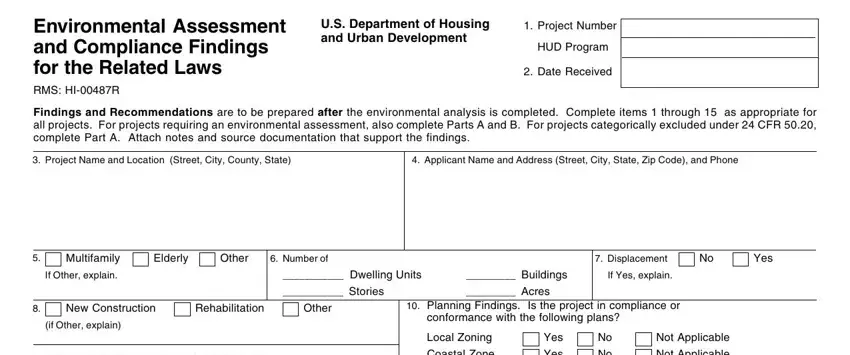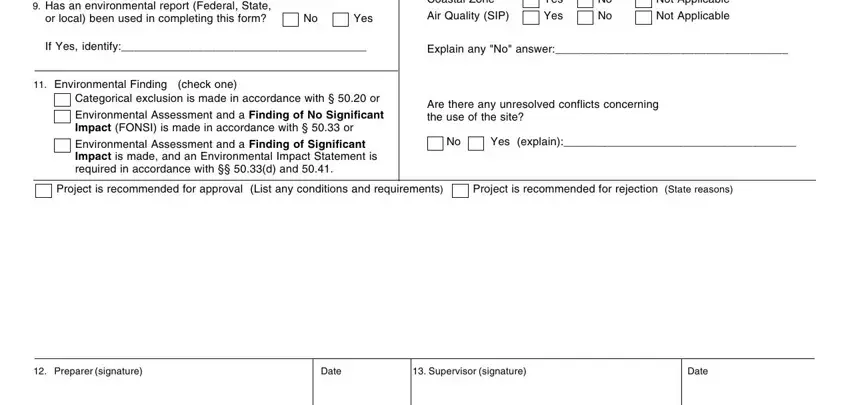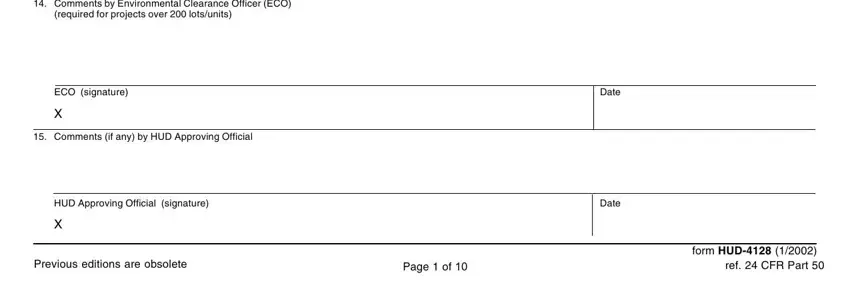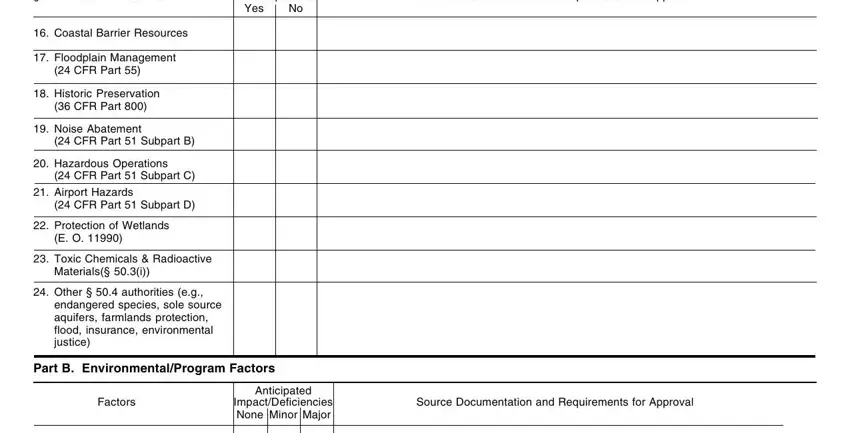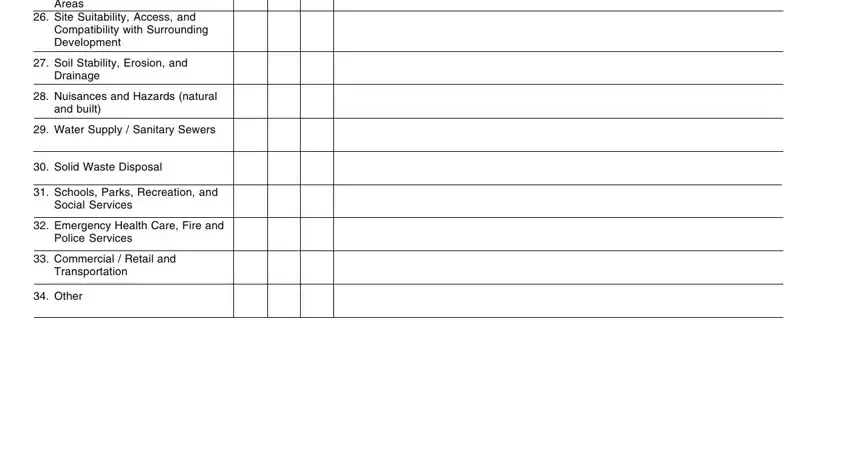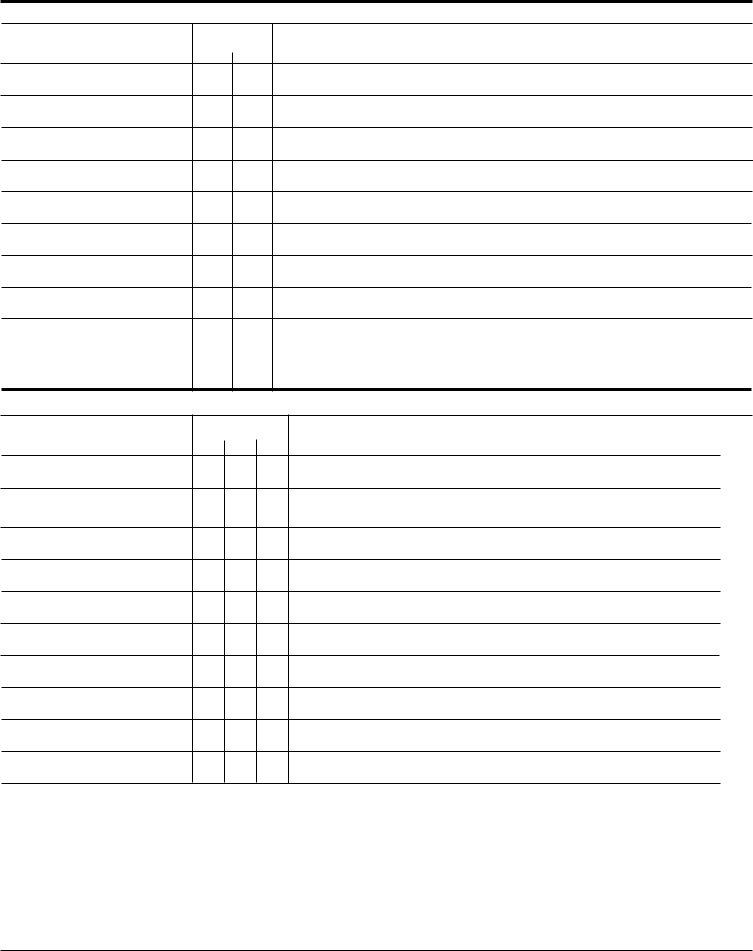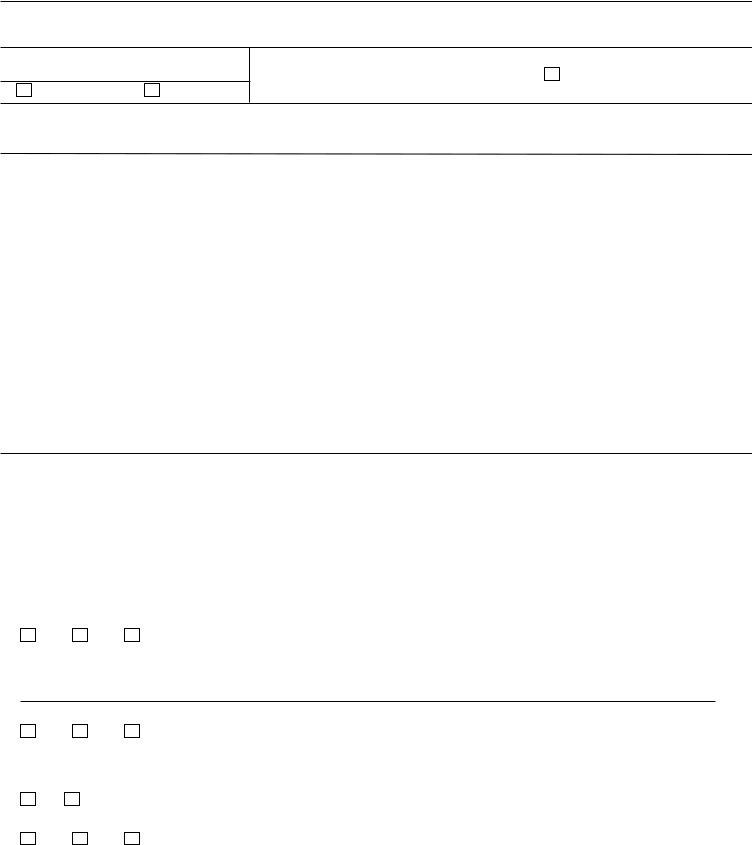Environmental Assessment and Compliance Findings for the Related Laws
RMS: HI-00487R
U.S. Department of Housing |
1. |
Project Number |
and Urban Development |
|
HUD Program |
|
|
|
2. |
Date Received |
Findings and Recommendations are to be prepared after the environmental analysis is completed. Complete items 1 through 15 as appropriate for all projects. For projects requiring an environmental assessment, also complete Parts A and B. For projects categorically excluded under 24 CFR 50.20, complete Part A. Attach notes and source documentation that support the findings.
3. Project Name and Location (Street, City, County, State)
4. Applicant Name and Address (Street, City, State, Zip Code), and Phone
Multifamily
If Other, explain.
6. Number of |
|
|
___________ Dwelling Units |
_________ |
Buildings |
___________ Stories |
_________ |
Acres |
7.Displacement If Yes, explain.
8. |
|
New Construction |
|
Rehabilitation |
|
Other |
(if Other, explain)
9.Has an environmental report (Federal, State,
or local) been used in completing this form? |
No |
Yes |
If Yes, identify:_______________________________________
11. Environmental Finding (check one)
Categorical exclusion is made in accordance with § 50.20 or
Environmental Assessment and a Finding of No Significant Impact (FONSI) is made in accordance with § 50.33 or
Environmental Assessment and a Finding of Significant Impact is made, and an Environmental Impact Statement is required in accordance with §§ 50.33(d) and 50.41.
10.Planning Findings. Is the project in compliance or conformance with the following plans?
Local Zoning |
Yes |
No |
Not Applicable |
Coastal Zone |
Yes |
No |
Not Applicable |
Air Quality (SIP) |
Yes |
No |
Not Applicable |
Explain any "No" answer:_____________________________________
Are there any unresolved conflicts concerning the use of the site?
No |
|
Yes (explain):_____________________________________ |
Project is recommended for approval (List any conditions and requirements)
Project is recommended for rejection (State reasons)
13. Supervisor (signature)
14.Comments by Environmental Clearance Officer (ECO) (required for projects over 200 lots/units)
15. Comments (if any) by HUD Approving Official
HUD Approving Official (signature)
X
|
|
form HUD-4128 (1/2002) |
Previous editions are obsolete |
Page 1 of 10 |
ref. 24 CFR Part 50 |
Part A. Compliance Findings for §50.4 Related Laws and Authorities
|
Project is |
|
§ 50.4 Laws and Authorities |
in Compliance |
Source Documentation and Requirements for Approval |
|
Yes |
No |
|
16.Coastal Barrier Resources
17.Floodplain Management (24 CFR Part 55)
18.Historic Preservation (36 CFR Part 800)
19.Noise Abatement
(24 CFR Part 51 Subpart B)
20.Hazardous Operations
(24 CFR Part 51 Subpart C)
21.Airport Hazards
(24 CFR Part 51 Subpart D)
22.Protection of Wetlands (E. O. 11990)
23.Toxic Chemicals & Radioactive Materials(§ 50.3(i))
24.Other § 50.4 authorities (e.g., endangered species, sole source aquifers, farmlands protection, flood, insurance, environmental justice)
Part B. Environmental/Program Factors
|
Anticipated |
|
Factors |
Impact/Deficiencies |
Source Documentation and Requirements for Approval |
|
None Minor Major |
|
25Unique Natural Features and Areas
26.Site Suitability, Access, and Compatibility with Surrounding Development
27.Soil Stability, Erosion, and Drainage
28.Nuisances and Hazards (natural and built)
29.Water Supply / Sanitary Sewers
30.Solid Waste Disposal
31.Schools, Parks, Recreation, and Social Services
32.Emergency Health Care, Fire and Police Services
33.Commercial / Retail and Transportation
34.Other
|
|
form HUD-4128 (1/2002) |
Previous editions are obsolete |
Page 2 of 10 |
ref. 24 CFR Part 50 |
Sample Field Notes Checklist
Project Number |
HUD Program |
|
|
Project Name:
Location (street, city, county/State, & zip code)
Number of Dwelling Units
New construction |
Rehabilitation |
Project site is in a location described as
|
Central city |
|
Suburban |
|
In developing rural area |
|
In undeveloped area |
|
|
Note to Reader: An Environmental Assessment (EA) is a concise public document that a Federal agency must prepare in order to comply with the National Environmental Policy Act (NEPA) and the related Federal environmental laws and authorities. The EA must support decision making process and provide a clear rationale, justification, and documentation for ratings assigned.
Instructions
It is recommended that this checklist be used by HUD staff who prepare the Environmental Assessment (EA; form HUD-4128). It will constitute full documentation for many factors on the EA, and partial documentation for others. It will avoid narrative reports and expedite the environmental review process. This checklist, which is a slightly revised version of Appendix C of Handbook 1390.2, should be used pending revision of Handbook 1390.2.
The number for each checksheet topic is the number that appears on form HUD-4128. Also, each checklist title/heading is followed by a reference to where the topic appears in the current Handbook 1390.2.
Before the site visit, review the Phase I and all background informa- tion submitted with the application (if applicable). During the site visit, the preparers of form HUD-4128 are to: (i) answer all relevant questions on this checklist; (ii) use the spaces provided for comments to include supplemental information as well as to record any recommended mitiga- tion measures or requirements for project approval; (iii) key your answers to the relevant questions (using additional sheets of paper to provide more detailed information); and (iv) use the spaces provided for source documentation to cite the information source used (e.g., title of
a technical report, map, or special study; site inspection/field observa- tion; name and location of the qualified data source(s) that provided the information, for example, the local planning agency, the local housing and/or community development agency, the State environmental protec- tion agency, the State Historic Preservation Officer, or other qualified data source.)
Preparers are to obtain and use, as appropriate, any environmental report (Federal, State, or local) that may have already been prepared for the property or area in which the property is located.
Several different types of maps will be useful in completing the review, such as the project plan or plot map, a location map showing major features and facilities in the vicinity, the USGS topographic map and FEMA flood map for the site area, and zoning/land use maps. Many of the conditions can and should be recorded directly on the project plan. Distances to major features and facilities (e.g., schools and fire stations) and a description of the surrounding area are examples. The plan can then be referenced as “source documentation” on form HUD- 4128.
9. Environmental Report
List the Federal, State, or local agencies contacted to obtain their existing environmental reports and other data for the HUD environmental review for the proposed project.
List the major reports obtained. (attach the report(s) or otherwise list the title, author, publication date)
10.Planning Findings
Is the project in compliance or conformance with the local zoning?
Yes |
No |
Not Applicable If No or Not Applicable, explain. |
Is the project located within a coastal management zone (CZM)? |
|
Yes |
No |
Not Applicable |
|
|
If your answer is Yes, the State Coastal Zone Management (CZM) Agency must make a finding |
that the project is consistent with |
the approved State CZM program. |
|
|
Is the State’s finding attached to this checksheet? |
|
|
Yes |
No |
|
|
|
Is the project in compliance with the air quality State Implementation Plan (SIP)? |
|
Yes |
No |
Not Applicable |
|
|
|
|
|
|
|
|
|
|
Page 3 of 10 |
form HUD-4128 (1/2002) |
Previous editions are obsolete |
ref. 24 CFR Part 50 |
Comments:
Source documentation:
Are there any unresolved conflicts concerning the use of the site?
Yes |
No |
If your answer is Yes, briefly explain: |
16.Coastal Barrier Resources
Is the project located within a coastal barrier designated on a current FEMA flood map or Department of Interior coastal barrier resources map?
Yes |
No |
If your answer is Yes, the law prohibits Federal funding of projects in designated coastal barriers. |
17.Flood Management (24 CFR Part 55) (see CF 3 and 4 of Handbook 1390.2)
Is the project located within a floodplain designated on a current FEMA flood map?
Yes |
No Identify FEMA flood map used to make this finding: |
Community Name and Number:
Map Panel Number and Date of Map Panel:
If your answer is Yes, use § 55.12 and the floodplain management decisionmaking process (§ 55.20) to comply with 24 CFR Part 55. Comments:
Source documentation: (attach § 55.20 analysis)
18.Historic Preservation (see CF 2 of Handbook 1390.2)
Has the SHPO been notified of the project and requested to provide comments?
Yes No
Is the property listed on or eligible for listing on the National Register of Historic Places?
Yes No
Is the property located within or directly adjacent to an historic district?
Yes No
Does the property’s area of potential effects include an historic district or property?
Yes No
If your answer is Yes to any of the above questions, consult with the State Historic Preservation Officer (SHPO) and comply with 36 CFR part 800. Has the SHPO been or is being advised of HUD’s finding?
Yes No Comments:
Source documentation:
19.Noise Abatement (see CF 1 of Handbook 1390.2)
Is the project located near a major noise source, i.e., civil airports (within 5 miles), military airfields (15 miles), major highways or busy roads (within 1000 feet), or railroads (within 3000 feet)?
Yes |
No |
If your answer is Yes, comply with 24 CFR 51, Subpart B which requires a noise assessment for proposed |
|
|
new construction. Use adopted DNL contours if the noise source is an airport. |
Comments: |
|
|
Source documentation: (attach NAG worksheets)
|
Page 4 of 10 |
form HUD-4128 (1/2002) |
Previous editions are obsolete |
ref. 24 CFR Part 50 |
20.Hazardous Industrial Operations (see CF 5 of Handbook 1390.2)
Are industrial facilities handling explosive or fire-prone materials such as liquid propane, gasoline or other storage tanks adjacent to or visible from the project site?
Yes |
No |
If your answer is Yes, use HUD Hazards Guide and comply with 24 CFR Part 51, Subpart C. |
Comments: |
|
|
Source documentation: (attach ASD worksheets)
21.Airport Hazards (see CF 5 of Handbook 1390.2)
Is the project within 3,000 feet from the end of a runway at a civil airport?
Yes No
Is the project within 2-1/2 miles from the end of a runway at a military airfield?
Yes |
No |
If your answer is Yes to either of the above questions, comply with 24 CFR Part 51, Subpart D. |
Comments:
Source documentation:
22.Protection of Wetlands (E.O. 11990) (see CF 3 and 4 of Handbook 1390.2) Are there drainage ways, streams, rivers, or coastlines on or near the site?
Yes No
Are there ponds, marshes, bogs, swamps or other wetlands on or near the site?
Yes No
For projects proposing new construction and/or filling, the following applies:
Is the project located within a wetland designated on a National Wetlands Inventory map of the Department of the Interior (DOI)?
Yes |
No |
If your answer is Yes, E.O. 11990, Protection of Wetlands, discourages Federal funding of new construction |
|
|
or filling in wetlands and compliance is required with the wetlands decisionmaking process (§ 55.20 of 24 CFR Part |
|
|
55. Use proposed Part 55 published in the Federal Register on January 1, 1990 for wetland procedures). |
Comments: |
|
|
Source documentation: (attach § 55.20 analysis for new construction and/or filling)
23. Toxic Chemicals and Radioactive Materials (see CF 5 of Handbook 1390.2)
Has a Phase I (ASTM) Report been submitted and reviewed?
Yes |
No |
If your answer is No, is a Phase I (ASTM) report needed? |
Yes |
No |
|
Are there issues that require a special/specific Phase II report before completing the environmental assessment?
Yes |
No |
Is the project site near an industry disposing of chemicals or hazardous wastes? |
Yes |
No |
Is the site listed on an EPA Superfund National Priorities or CERCLA, or equivalent State list?
Is the site located within 3,000 feet of a toxic or solid waste landfill site?
Does the site have an underground storage tank?
If your answer is Yes to any of the above questions, use current techniques by qualified professionals to undertake investigations determined necessary and comply with § 50.3(i).
Are there any unresolved concerns that could lead to HUD being determined to be a Potential Responsible Party (PRP)? Yes No
Comments:
Source documentation: (attach Phase I (ASTM) Report)
|
Page 5 of 10 |
form HUD-4128 (1/2002) |
Previous editions are obsolete |
ref. 24 CFR Part 50 |
24. Other
a.Endangered Species (see EF 3.4 of Handbook 1390.2)
Has the Department of Interior list of Endangered Species and Critical Habitats been reviewed?
Yes |
No |
|
Is the project likely to affect any listed or proposed endangered or threatened species or critical habitats? |
Yes |
No |
If your answer is Yes, compliance is required with Section 7 of the Endangered Species Act, which mandates |
consultation with the Fish and Wildlife Service in order to preserve the species. Comments:
Source documentation
b.Sole Source aquifers
Will the proposed project affect a sole source or other aquifer?
Yes No Comments
Source documentation
c.Farmlands Protection (see EF 3.3 of Handbook 1390.2)
If the site or area is presently being farmed, does the project conform with the Farmland Protection Policy Act and HUD policy memo?
Yes |
No |
If your answer is Yes, compliance is required with 7 CFR Part 658, Department of Agriculture regulations |
implementing the Act. Comments:
Source documentation:
d.Flood Insurance
Is the building located or to be located within a Special Flood Hazard Area identified on a current Flood Insurance Rate Map (FIRM)?
Yes |
No |
If your answer is Yes, flood insurance protection is required for buildings located or to be located within a |
|
|
Special Flood Hazard Area as a condition of approval of the project. In addition, compliance with § 55.12 and |
|
|
the floodplain management decisionmaking process (§ 55.20) is required (refer to item #17 above). Document |
|
|
the map used to determine Special Flood Hazard Area in above item #17 pertaining to community name and |
|
|
number, map panel number and date of map panel. |
e. Environmental Justice
Is the project located in a predominantly minority and low-income neighborhood?
Does the project site or neighborhood suffer from disproportionately adverse environmental effects on minority and low-income populations relative to the community-at-large?
Yes |
No |
If your answer is Yes, compliance is required with E.O. 12898, Federal Actions to Address Environmental Justice. |
Comments:
Source documentation:
25.Unique Natural Features and Areas (see EF 3.2 of Handbook 1390.2)
Is the site near natural features (i.e., bluffs or cliffs) or near public or private scenic areas?
Yes No
Are other natural resources visible on site or in vicinity? Will any such resources be adversely affected or will they adversely affect the project?
Yes No Comments:
|
Page 6 of 10 |
form HUD-4128 (1/2002) |
Previous editions are obsolete |
ref. 24 CFR Part 50 |
26. Site Suitability, Access, and Compatibility with Surrounding Development (see EF 1.1 and 1.3 of Handbook 1390.2)
Has the site has been used as a dump, sanitary landfill or mine waste disposal area? |
Yes |
No |
Is there paved access to the site? |
Yes |
No |
Are there other unusual conditions on site? |
Yes |
No |
Is there indication of: distressed vegetation waste material/containers soil staining, pools of liquid loose/empty drums, barrels
Yes No |
Yes No |
|
oil/chemical spills |
|
abandoned machinery, cars, refrigerators, etc. |
|
transformers, fill/vent pipes, pipelines, drainage structures |
Is the project compatible with surrounding area in terms of: |
|
Yes |
No |
Yes |
No |
Land use |
|
Building type (low/high-rise) |
|
Height, bulk, mass |
|
Building density |
|
Will the project be unduly influenced by: |
|
|
Yes |
No |
Yes |
No |
Building deterioration |
|
Transition of land uses |
|
Postponed maintenance |
|
Incompatible land uses |
|
Obsolete public facilities |
|
Inadequate off-street parking |
|
Are there air pollution generators nearby which would adversely affect the site: |
|
Yes |
No |
Yes |
No |
Heavy industry Incinerators
Power generating plants Cement plants
Comments:
Large parking facilities (1000 or more cars) Heavy travelled highway (6 or more lanes) Oil refineries
Other(specify)
27. Soil Stability, Erosion, and Drainage |
(see EF 1.2 of |
Handbook 1390.2) |
Yes |
Slopes: |
Not Applicable |
Steep |
Moderate |
Slight |
|
Is there evidence of slope erosion or unstable slope conditions on or near the site?
Is there evidence of ground subsidence, high water table, or other unusual conditions on the site?
Is there any visible evidence of soil problems (foundations cracking or settling, basement flooding, etc.)
in the neighborhood of the site?
Have soil studies or borings been made for the project site or the area?
Do the soil studies or borings indicate marginal or unsatisfactory soil conditions?
Is there indication of cross-lot runoff, swales, drainage flows on the property?
Are there visual indications of filled ground?
If your answer is Yes, was a 79(g) report/analysis submitted?
Are there active rills and gullies on site?
If the site is not to be served by a municipal waste water disposal system, has a report of the soil
conditions suitable for on-site septic systems been submitted?
Is a soils report (other than structural) needed?
Are structural borings or a dynamic soil analysis/geological study needed?
Comments:
Source documentation:
|
Page 7 of 10 |
form HUD-4128 |
(1/2002) |
Previous editions are obsolete |
ref. 24 CFR |
Part 50 |
28.Nuisances and Hazards (see EF 1.3 and 1.4 of Handbook 1390.2) Will the project be affected by natural hazards:
Faults, fracture
Cliffs, bluffs, crevices
Slope-failures from rains
Unprotected water bodies
Will the project be affected by built hazards and nuisances: Yes
Hazardous street Dangerous intersection Through traffic Inadequate separation of pedestrian/vehicle traffic Children’s play areas located next to
freeway or other high traffic way Inadequate street lighting Quarries or other excavations Dumps/sanitary landfills or mining Railroad crossing
Will the project be affected by nuisances:
Yes
Gas, smoke, fumes Odors Vibration Glare from parking area
Vacant/boarded-up buildings
Comments:
Source documentation:
29.Water, Supply, Sanitary Sewers, and Solid Waste Disposal Is the site served by an adequate and acceptable:
Fire hazard materials
Wind/sand storm concerns
Poisonous plants, insects, animals
Hazardous terrain features
No |
Yes |
No |
Inadequate screened drainage catchments |
|
|
Hazards in vacant lots |
|
|
Chemical tank-car terminals |
|
|
Other hazardous chemical storage |
|
|
High-pressure gas or liquid petroleum |
|
|
transmission lines on site |
|
|
Overhead transmission lines |
|
|
Hazardous cargo transportation routes |
|
|
Oil or gas wells |
|
|
Industrial operations |
|
|
No Yes |
No |
|
Unsightly land uses |
|
|
Front-lawn parking |
|
|
Abandoned vehicle |
|
|
Vermin infestation |
|
|
Industrial nuisances |
|
|
Other (specify) |
|
|
(see EF 2.1, 2.2, and 2.4 of Handbook 1390.2)
water supply
Yes No Municipal Private
sanitary sewers and waste water disposal systems Yes No Municipal Private
trash collection and solid waste disposal
Yes No Municipal Private
If the water supply is non-municipal, has an acceptable “system” been approved by appropriate authorities and agencies? Yes No
If the sanitary sewers and waste water disposal systems are non-municipal, has an acceptable “system” been approved by appropriate authorities and agencies?
Yes No
Comments:
Source documentation:
|
Page 8 of 10 |
form HUD-4128 (1/2002) |
Previous editions are obsolete |
ref. 24 CFR Part 50 |

31. Schools, Parks, Recreation, and Social Services (see U/EF 4, 5, and 6 of Handbook 1390.2)
Will the local school system have the capability to service the potential school age children from the project? Yes No
Are parks and play spaces available on site or nearby? Yes No
Will social services be available on site or nearby for residents of the proposed project? Yes No
Comments:
Source documentation:
32. Emergency Health Care, Fire and Police Services (see U/EF 7, 8, and 9 of Handbook 1390.2)
Are emergency health care providers located within reasonable proximity to the proposed project?
Yes |
No |
Approximate response time: _______________ |
Are police services located within reasonable proximity to the proposed project? |
Yes |
No |
Approximate response time: _______________ |
Is fire fighting protection |
municipal |
volunteer adequate and equipped to service the project? |
Yes |
No |
Approximate/estimated response time:________ |
Comments: |
|
|
|
|
Source documentation:
33. Commercial/Retail and Transportation (see U/EF 10 and 11 of Handbook 1390.2)
Are commercial/retail shopping services nearby?
Is the project accessible to employment, shopping and services by
public transportation or |
|
private vehicle? |
Is adequate public transportation available from the project to these facilities?
Are the approaches to the project convenient, safe and attractive?
|
Page 9 of 10 |
form HUD-4128 (1/2002) |
Previous editions are obsolete |
ref. 24 CFR Part 50 |
11.Conditions and Requirements for Approval Are mitigation measures required?
Yes No
If your answer is Yes, list and describe:
Brief Description of the Project:
Field Inspection on (date) _________________________ |
By (signature) ________________________________________ |
|
|
|
|
|
Page 10 of 10 |
form HUD-4128 (1/2002) |
Previous editions are obsolete |
ref. 24 CFR Part 50 |
